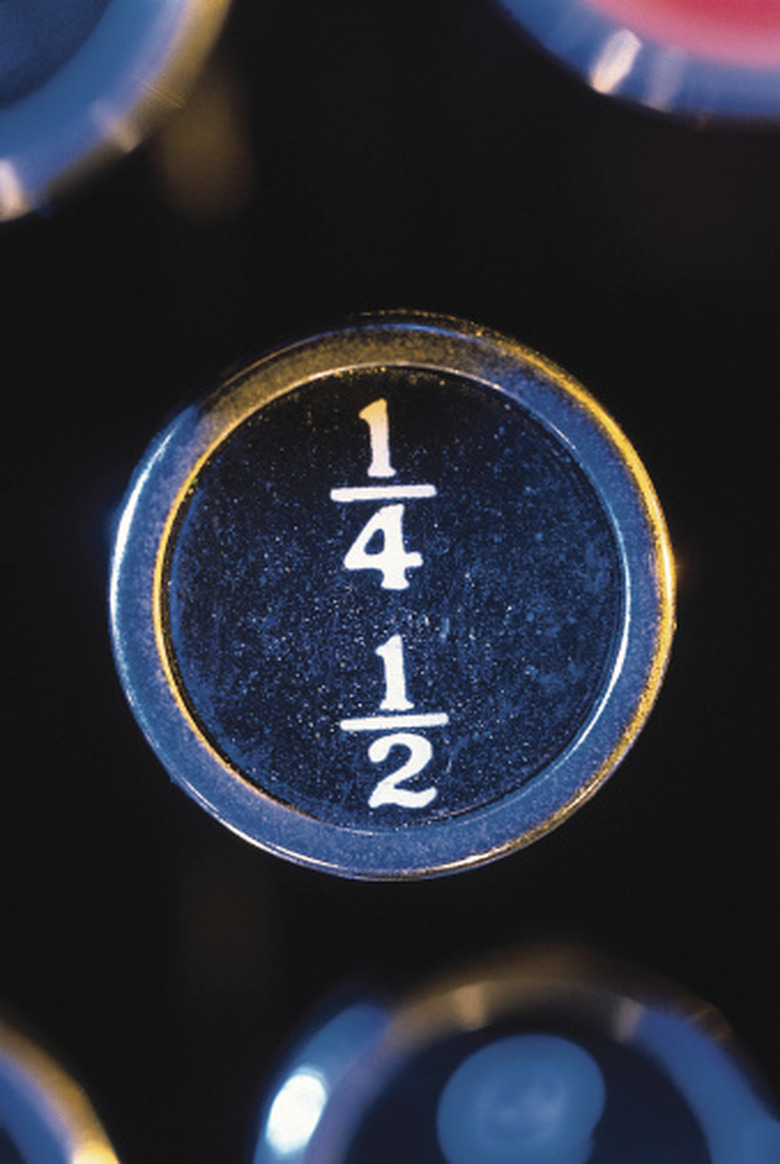How To Do Fraction Problems In Math
Fractions are composed of the number of parts (numerator) divided by how many parts make a whole (denominator). For example, if there are two slices of pie and five pieces make a whole pie, the fraction is 2/5. Fractions, like other real numbers, can be added, subtracted, multiplied or divided. Completing fraction problems in math require skills in vocabulary, addition, subtraction, multiplication and division.
Step 1
Learn fraction terminology. In a fraction, the numerator (the first number, or the number on the top) represents a portion of the whole, and the denominator (the second number, or the number on the bottom) represents the whole. For example, in the fraction 3/4, the numerator is 3 and the denominator is 4. A proper fraction is one where the numerator is less than the denominator, such as 1/2. An improper fraction is one where the numerator is equal to or greater than the denominator, such as 3/2. A whole number can be expressed as an improper fraction by giving it a denominator of 1; for example, 5 is equal to 5/1. A mixed number is one that includes a whole number and a fraction, such as 1-1/2 (that is, "one and a half").
Step 2
Learn to convert mixed numbers to improper fractions. Multiply the denominator by the whole number and add this result to the numerator; for example, to convert 1-3/4, multiply the denominator (4) by the whole number (1) and add that result to the original numerator (3), yielding a result of 7/4. You will need to convert mixed numbers to improper fractions before you try to add, subtract, multiply or divide them.
Step 3
Learn to find a fraction's reciprocal. A fraction's reciprocal is the multiplicative inverse of the fraction; that is, if you multiply a fraction by its reciprocal, the result is equal to 1. You can find a fraction's reciprocal by "turning it upside down," reversing its numerator and denominator; for example, the reciprocal of 3/4 is 4/3.
Step 4
Learn to simplify fractions by finding the greatest common factor. Determine the factors of both the numerator and denominator, then divide both by the largest factor they have in common. For example, for the fraction 4/8, find the common factors of 4 and 8; the factors of 4 are 1, 2 and 4, and the factors of 8 are 1, 2, 4 and 8. Since the greatest common factor of 4/8 is four, divide both the numerator and denominator by 4. The simplified answer is 1/2.
Simplifying fractions can be very helpful after adding, subtracting, multiplying or dividing; quite often, the result can be expressed in a simpler form, so you should always check your answer to see if it can be simplified as shown here.
Step 5
Learn to find the least common denominator of two fractions, such as 3/8 and 5/12. Factor each denominator into prime numbers, keeping track of how many times you use each prime number; for example, the prime factors of 8 are 2, 2, and 2, and the prime factors of 12 are 2, 2, and 3. Note the largest number of times each prime factor is used in any one denominator; in this case, 2 is used a maximum of 3 times, and 3 is used just once. Multiply these numbers together to find the least common denominator; for 8 and 12, multiply 2 × 2 × 2 × 3 = 24, so 24 is the least common denominator.
Step 6
Add and subtract fractions with the same denominator by adding or subtracting their numerators, respectively. For example, 1/8 + 3/8 = 4/8, and 5/12 – 2/12 = 3/12. The numerators are added, but the denominators stay the same.
Step 7
Add and subtract fractions with different denominators by finding the least common denominator, as shown in Step 5. For each fraction, divide the least common denominator by that fraction's original denominator, then multiply both the numerator and denominator by that result. For example, 3/8 and 5/12 have a least common denominator of 24. Since 24/8 = 3, so multiply both the numerator and denominator of 3/8 by 3 to yield 9/24; similarly, since 24/12 = 2, so multiply both the numerator and denominator of 5/12 by 2 to yield 10/24.
Once the two numbers have the same denominator, they can be added or subtracted as described in Step 6; in this case, 9/24 + 10/24 = 19/24.
Step 8
Multiply fractions by multiplying the numerators of each fraction and the denominators of each fraction to yield the product. For example, when multiplying 1/2 and 3/4, you would multiply the numerators (1 × 3 = 3) and the denominators (2 × 4 = 8), yielding a final answer of 3/8.
Step 9
Divide fractions by taking the reciprocal of the second fraction (the divisor) and multiplying the two fractions as shown in Step 8. In the example of 2/3 ÷ 1/2, first change 1/2 to its reciprocal, 2/1, and then multiply 2/3 and 2/1 to find the quotient of 4/3 (2/3 × 2/1 = 4/3).
TL;DR (Too Long; Didn't Read)
Solving fraction problems is a skill that requires practice in order to succeed. As one becomes familiar with the vocabulary and sequence of skills required for adding, subtracting, multiplying and dividing fractions, it will become easier to use these skills.
Cite This Article
MLA
Race, Glenda. "How To Do Fraction Problems In Math" sciencing.com, https://www.sciencing.com/do-fraction-problems-math-8218014/. 24 April 2017.
APA
Race, Glenda. (2017, April 24). How To Do Fraction Problems In Math. sciencing.com. Retrieved from https://www.sciencing.com/do-fraction-problems-math-8218014/
Chicago
Race, Glenda. How To Do Fraction Problems In Math last modified August 30, 2022. https://www.sciencing.com/do-fraction-problems-math-8218014/
